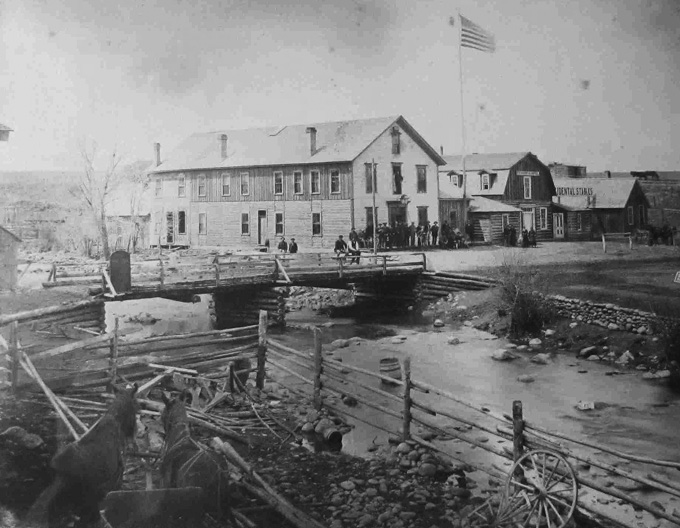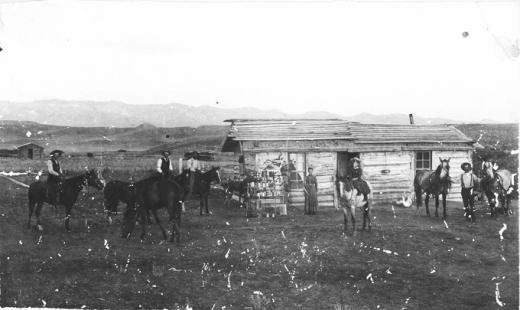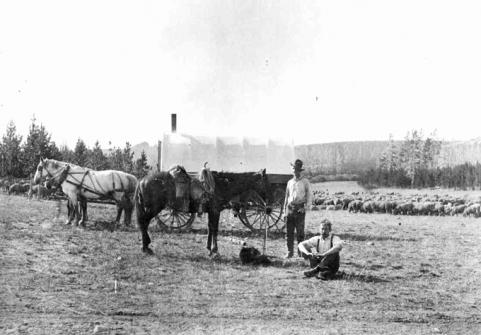- Home
- Encyclopedia
- Johnson County, Wyoming
Johnson County, Wyoming
Johnson County, in the north-central region of Wyoming, isn’t the biggest county by population or square miles, but it looms large in the history of the state and the West.
Many of the iconic themes in western history were played out on the stage of the Powder River and Bighorn country that makes up the plains, foothills and mountains of Johnson County.
In the 18th and 19th centuries, people in what’s now Johnson County witnessed:
- Inter-tribal rivalries that epitomized the northern Plains horse culture;
- Beaver trapping by mountain men in the Bighorns;
- Military, trapper and trader exploration and the establishment of several trading posts and military forts, as well as use of the Bozeman Trail by wagon trains;
- Indian attacks on wagon trains and forts;
- The Fetterman Fight, the biggest Indian victory on the northern plains before the Little Big Horn battle, and predating it by a decade;
- The rise of the cowboy and cattle baron, and the decline of open-range cattle empires, culminating with the Johnson County War.
Pre-European History
The arrival of the Spanish horse dramatically changed American Indian cultures on the prairies, mountains and even in the forests surrounding the Great Lakes. The hunter and gatherer bands that traveled on foot were replaced by much more mobile groups that could hunt buffalo on horseback.
For the equestrian culture of the Plains, the sweet spot—both culturally and ecologically—was the Powder River country. Farther north, winters were too cold for large horse herds. Farther south, tribes bred horses to excess, straining the ecological carrying capacity of the grasslands and trading egalitarian societies for unequal wealth measured in the size of one’s herd. The Powder River country was prime buffalo hunting grounds for the Sioux, whose horse herds were just the right size for the regional grassland habitat. The Sioux managed to keep their egalitarian traditions as they emerged as the dominant horse culture of the Plains tribes.

Fur Trappers
Recorded European history in the area largely begins after the 1803 Louisiana Purchase. Although the Verendrye brothers, French traders and explorers, were in the neighborhood as early as 1742, it is unclear whether they reached the Black Hills of South Dakota, the Bighorns of northern Wyoming or the Laramie Range of central Wyoming, to the south. In all likelihood, the first European to set foot in Johnson County was Francois Antoine Larocque of the Northwest Company, traveling through the area with the Crow in 1805. Later, in 1811, the Wilson Price Hunt expedition, commissioned by John Jacob Astor’s American Fur Company, came through the Powder River Basin and over the Bighorn range. Critically, in 1812 an expedition of some of the same Astorians from the mouth of the Columbia, headed by Robert Stuart , came through the region farther south and discovered the South Pass route over the Continental Divide and down the Sweetwater and North Platte rivers. That route proved so popular, as evidenced by its later use as the Oregon/California/Mormon Trail that the Johnson County area was bypassed by people of European descent—with the exception of a few fur trade parties--for more than two decades.
In 1834, Antonio Montero built a trading post on the Middle Fork of Powder River about 11 miles east of present-day Kaycee, Wyo. The stockade and buildings became known as the Portuguese Houses and served as a center for trade with the Crow for a few years. In 1839, a rival fur company--Jim Bridger and 300 members of the Fontenelle, Fitzpatrick and Company--wintered nearby and harassed the Montero operation—competing aggressively for its Crow customers and nearly eliminating the beaver supply—setting the stage for the post’s ultimate abandonment.
For the remainder of the 1840s and much of the 1850s, trade activity gravitated toward the Sweetwater and Platte emigrant route, leaving what’s now northern Wyoming empty of commerce with whites, with no regular trading post settlements. By the mid-1850s, relations between the northern tribes and the U.S. military were deteriorating, thanks in part to the Grattan Massacre in 1854 near Fort Laramie, when Lt. John Grattan, 29 troops and Brulé Sioux headman Conquering Bear were killed at a Brulé village in a dispute over a strayed cow. That event was followed by subsequent military expeditions to punish the Sioux, and the army at the same time felt the need for better maps of the region.
Indian wars
From the late 1600s to the mid-1850s, the western Sioux advanced westward from the Minnesota River across what are now Nebraska and the Dakotas to the headwaters of the Yellowstone River and south to the Republican River. This westward movement by the Lakota Sioux created a domino effect on the prior residents—the Crow, Shoshone and Cheyenne tribes. In the early 1860s, prospectors and miners were spilling from the California gold fields into Idaho and Montana territories. In 1863, this prompted mountain man John Jacobs and partner John M. Bozeman to promote a new trail based on ancient Indian and trapper trails. This route, named for Bozeman, led north from the Oregon Trail in what’s now central Wyoming to the gold fields around Virginia City, Montana Territory.
The problem with the Bozeman Trail was that it ran through the heart of the Powder River country—the premier buffalo hunting ground for the Lakota, Arapaho and Cheyenne tribes. The Indians warned of trouble, but throughout 1864 and 1865, some 2,000 pioneers traveled the Bozeman Trail despite escalating attacks by the tribes. In the spring of 1866, officials from the U.S. Army and the Office of Indian Affairs called for a meeting and sought a treaty with the northern Plains tribes at Fort Laramie. In a terrible case of bad timing, a 700-man detachment led by Col. Henry B. Carrington arrived in the middle of these delicate treaty negotiations with the news that he had orders to build three new forts along the Bozeman Trail.

Oglala Sioux war leader Red Cloud was livid. He stormed out of the meeting, promising death to any whites who dared to cross the Powder River country. Carrington nevertheless carried on, overseeing construction of the three forts, and provoking what came to be known as Red Cloud’s War. Carrington’s troops soon came under escalating hassessment and then siege by Red Cloud and hundreds, then thousands of warriors. Army work parties sent to gather forage for horses or wood for building the forts were regularly harassed.
In November 1866, a brash Civil War hero, Capt. William Judd Fetterman, arrived at Fort Phil Kearny, north of today’s town of Buffalo, bragging that with only 80 men, he could “ride through the Sioux nation.” A month later, he rode with 80 men, mixed cavalry and infantry, to rescue a wood-gathering party two miles from the fort. Fetterman was lured by fleeing warriors over a nearby ridge and into a trap laid by Red Cloud and 1,000 Indians. Fetterman and his command were all killed.
Inspired by this victory and energized by the religious power of the annual Sun Dance, Red Cloud’s warriors continued their attacks into the next year. In August 1867, a final push was launched against Fort Kearny and Fort C. F. Smith. A thousand warriors zeroed in on a wood-gathering party, just north of what’s now the Johnson County line. Capt. James Powell pulled workers and soldiers inside a corral of wagon boxes, and blazed away at the attacking Indians with new breech-loading Springfield rifles. A 110-man rescue column was sent from Fort Kearny, with a howitzer. A single burst of shrapnel from an overhead shell scattered the charging warriors. The Wagon Box Fight was over.
A war-weary nation wasn’t interested in distant Indian wars. Gen. U.S. Grant ordered the forts closed in March 1868. Over the following months the army abandoned the forts, and the tribes burned them. Meanwhile in May and June 1868 the government and the tribes of the northern plains signed a treaty at Fort Laramie, allowing the Sioux the right to continue to hunt in the Powder River Basin. The following November, Red Cloud signed the treaty. He had won the war.
For a few years in the 1870s, Indian-white conflict tapered off in what now was northern Wyoming Territory. In 1874, Lt. Col. George A. Custer led a gold-seeking expedition to the Black Hills of Dakota and Wyoming—land that had been reserved for the Sioux in the 1868 treaty. Custer’s expedition made rumors of Black Hills gold official. The government pressured the tribes to sell, but they refused, and in 1876 the government demanded they abandon the Powder River country and come onto reservations in Dakota Territory and Nebraska.
What followed became known as the Great Sioux War of 1876, and included Custer’s defeat and death on the Little Bighorn in June. In what soon would become Johnson County, Col. Ranald Mackenzie and a force of infantry, cavalry and Indian scouts attacked Dull Knife’s village of Cheyenne people on the Red Fork of Powder River in November 1876.
In 1877 the tribes surrendered and relocated to the reservations.

Post-Indian Wars
In 1878, ranchers like the British Moreton Frewen and others began scouting what’s now Johnson County for ranges for their cattle. The 1880s saw a cattle boom. Ranchers, fueled with capital from New York, Boston, London and Edinburgh, got rich. By the end of the decade many had gone broke – largely thanks to the terrible winter of 1886-87, which decimated the cattle herds.
Still, the military was interested in outposts in the Powder River country, if only to keep watch for Indians straying from nearby reservations. In the 1876 campaign, the army had located Cantonment Reno at the Bozeman Trail crossing of Powder River. It was renamed Fort McKinney for an officer killed in Mackenzie’s attack on the Dull Knife village. In 1878, for better supplies of water, forage and wood, the fort was relocated 45 miles northwest to a site on Clear Creek where it spilled out of the Bighorns.
A village to provide supplies and service the fort concurrently sprang up downstream – just outside the fort’s military reservation boundary. The community was soon dubbed “Buffalo” – a name drawn from a hat and offered by a native of Buffalo, New York. To feed the 300-plus soldiers and the cavalry horses of the fort, ranchers and farmers raised cattle, hay and food crops. Merchants, traders, lawyers, teachers, miners, preachers and their families filtered in, and all sheltered in the figurative shadow of the fort. Saloons, including one in the 1880- established Occidental Hotel, entertained all comers. Buffalo was incorporated as a town in 1884.
Early Johnson County
In 1875, the Wyoming Legislature detached the northern portion of gigantic Carbon County, to create Pease County. Yet because there were not enough settlers, Pease County was never organized. In late 1879, the legislature created Johnson County (named for E. P. Johnson, a Cheyenne attorney) out of the northern portion of the non-functional Pease County. After 300 signatures were gathered, Johnson County was formally recognized in 1880. An organizational election was held April 19, 1881 and the new county government formed on May 10 of that year – seated in Buffalo. Initially, Johnson County included all of today’s Johnson County, all of today’s Sheridan County and the portions of today’s Big Horn and Washakie counties east of the Big Horn River.
Modern Era
By the 1880s, Buffalo was becoming headquarters for small homestead ranchers who attracted the ire of Cheyenne-based cattle barons. In April 1892 these tensions erupted into the so-called Johnson County War, when a private, 50-man army of landowners and range detectives invaded Johnson County intending to kill men they believed were cattle thieves.
The invaders killed Nate Champion and Nick Ray at the KC Ranch at present Kaycee, Wyo. They were later besieged for most of three days at the TA Ranch south of Buffalo by a posse of hundreds of armed locals, before troops from Fort McKinney lifted the siege and escorted the invaders to safety. Venue for the criminal case was moved to Cheyenne, where the invaders were charged with murder. But likely witnesses had disappeared, Johnson County ran out of funds to pay for prosecution, and the case never came to trial.
Writer Owen Wister visited Buffalo and the TTT Ranch in southern Johnson County in 1891. Observations gleaned there and in many other parts of Wyoming about cowboys and ranch life fill his book, The Virginian, the central conflict of which is between rustlers and cattle barons. The book sold millions of copies and is considered to be the first popular western novel. The book opened the field to writers like of Zane Grey and Louis L’Amour, and hundreds of western movies and TV shows.
Later development
The Bighorn National Forest Reserve—precursor of the present Bighorn National Forest--was created in 1897, but there was plenty of tie hacking activity in the forest, producing many thousands of railroad ties for the expanding state and national rail networks.

>Rail service, however, was slow to reach Buffalo. The Burlington Railroad first entered Wyoming near Newcastle in 1890. The line crossed the Powder River in 1892, and built on up Clear Creek through Clearmont, before turning north and reaching Sheridan by the end of the year.
At the time, the railroad opened bids for construction of a spur from Clearmont to Buffalo, but uncertainties about local politics and stability at the time of the Johnson County War led the company to abandon those plans. Finally, Buffalo promoters started the Wyoming Railroad Company, which built a spur from Clearmont to Buffalo that ran from 1913 to 1918—called by locals the Duffy.
After the military abandoned Fort McKinney in 1894, the post reverted to the state, which converted the facility into the State Soldier and Sailor Home in 1903.[1] It continues to operate today as the Wyoming Veterans Home. The first area ranch to convert to “dude” ranch tourism was the H-F Bar in 1911.[2] More would follow in the decades to come.
In the 20th century, Buffalo-area sheep operations, like many others around the West, recruited herders from the Basque country of northern Spain, who settled and stayed in the community. For 40 years, local radio station KBBS broadcast Sunday Basque Hour to reach Basque herders and their families.
As for mineral resources, Johnson County’s coal seams were too deep for strip mining ever to take hold. There’s been some moderately productive oil and gas activity, punctuated by exploration and production spikes from coal-bed methane –accessed by shallow wells into the coal seams—in the 1990s and first decade of the 21st century. Also in the first two decades of the 21st century has been some drilling for natural gas into the Niobrara shale, a formation that underlies much of eastern Wyoming.
Despite these changes, Buffalo and the small town of Kaycee to the south on Interstate 25 still reflect their agricultural heritage. Both communities recognize the value of history, investing in the Jim Gatchell Memorial Museum and the Hoofprints of the Past Museum, respectively. In addition to its well-documented involvement with Indian and cattle wars in Johnson County, Kaycee is located near the bandit hideout Hole-in-the-Wall supposedly used by Butch Cassidy, the Sundance Kid and other thieves.
In the 21st century, oil and gas drilling and pipeline operations have raised Johnson County’s tax assessment to over $1 billion. That’s led to a multi-million dollar boom in public infrastructure projects, including water and sewer treatment plants, replacement of aging water/sewer lines, new school buildings and a new Justice Center that includes space for courts, law enforcement and a new jail.
Resources
Primary Sources
- Wister, Fanny Kemble, ed. Owen Wister Out West: His Journals and Letters. Chicago: University of Chicago Press, 1958, 114-120.
Secondary Sources
- Bollinger, Gil and the Jim Gatchell Memorial Museum. Buffalo. Charleston, S.C.: Arcadia Pub. 2009
- Clow, Richard L. “Mad Bear: William S. Harney and the Sioux Expedition of 1885 – 1856.” Nebraska History 61 (1980): 132-151.
- Graulich, Melody and Stephen Tatum. Reading the Virginian in the New West. Lincoln, Neb.: University of Nebraska Press, 2003.
- Hafen, LeRoy R., ed. The Mountain Men and the Fur Trade of the Far West. Vol 5. Glendale, Calif.: The Arthur H. Clark Company, 1966.
- Hamalainen, Pekka. “The Rise and Fall of Plains Indian Horse Culture." Journal of American History Vol 90, No. 3, 3-21. Available as of Oct. 16, 2012 for pay-per-view access at http://jah.oxfordjournals.org/content/90/3.toc.
- Hanson, Margaret Brock, ed. “Powder River Country: The Papers of J. Elmer Brock.” Frontier Printing, Inc., Cheyenne. 1981.
- McCaig, Donald. “The Bozeman Trail.” Smithsonian, October 2000 Vol. 31, No. 7.
- Murray, Robert A. Johnson County: 175 years of history at the foot of the Big Horn Mountains. Buffalo, Wyo.: Buffalo Chamber of Commerce, 1981.
- Peterson, Gary. “Antonio Montero and the Portuguese Houses: An Outpost on Powder River.” Rocky Mountain Fur Trade Journal vol. 2, 2008, 31-47. Published by the Museum of the Mountain Man, Pinedale, Wyoming.
- Spaulding, Kenneth A., ed. On the Oregon Trail: Robert Stuart’s Journey of Discovery. Norman, Okla: University of Oklahoma Press, 1953.
- Victor, Frances Fuller. The River of the West: The Adventures of Joe Meek. 2 vols. Missoula, Mont.: Mountain Press Publishing Company, 1983.
- White, Richard. “The Winning of the West: The Expansion of the Western Sioux in the Eighteenth and Nineteenth Centuries.” Journal of American History 65, no. 2 (September 1978): 319-343.
- Wyoming State Historic Preservation Office. ”National Register of Historic Places: Fort McKinney.” Accessed Oct. 4, 2012, at http://wyoshpo.state.wy.us/NationalRegister/Site.aspx?ID=200.
Illustrations
The photos of Buffalo in 1883 and 1918, and the photos of the sheepherders and the Fullerton homestead are all from the Johnson County Jim Gatchell Memorial Museum. Used with permission and thanks.
The photo of Buffalo’s main street around 1930 is from Wyoming Tales and Trails. Used with thanks.
[1]Buffalo Bulletin, June 11, 1903.
[2] Buffalo Bulletin, May 18, 1911.
